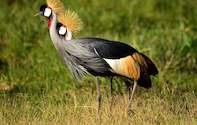
Furthermore, recent surveys in countries long thought to be strongholds for Wattled cranes, namely Botswana, Mozambique, Tanzania, and Zambia, show that the global Wattled Crane population is only half of what has been reported in recent years.A workshop was held in Naivasha, Kenya last year to develop a mitigation plan for the protection of African cranes. Facilitated by the Conservation Breeding Specialist Group (CBSG) southern Africa, the workshop hosted 25 participants from eight countries, representing local communities, NGOs, universities, governments and zoos.African Cranes Wetlands And Communities is a joint initiative between the Endangered Wildlife Trust (EWT) and the International Crane Foundation (ICF). It aims to conserve cranes and their habitats, by promoting cooperation among African nations, in partnership with the people who depend on these same habitats for their livelihoods. In addition to the African Crane Trade Project, the programme is planning the development of a satellite tracking project for wattled Cranes across the southern African subregion, to be coordinated under the African Wattled Crane Programme.The African Crane Trade Project is developing a model program to decrease the impact of captive crane trade on wild cranes, by targeting supply demand within Africa globally. The distribution of the Black and Wattled Cranes also transcends boundaries of many countries.South Africa is the main stronghold for the blue crane, it is home to a number of 20 000 birds. The endangered Grey Crowned Crane is found across 13 countries in eastern and southern Africa, including South Africa. There are populations of Grey Crowned Cranes in rural landscapes in Eastern Cape.Continuous research and monitoring are managed by the EWT to establish other innovative mitigation to protect the crane.

